Jie Tang
Tony
Reimagining Wireless Connectivity: The FAS-RIS Synergy for 6G Smart Cities
Dec 22, 2025Abstract:Fluid antenna system (FAS) represents the concept of treating antenna as a reconfigurable physical-layer resource to broaden system design and network optimization and inspire next-generation reconfigurable antennas. FAS can unleash new degree of freedom (DoF) via antenna reconfigurations for novel spatial diversity. Reconfigurable intelligent surfaces (RISs) on the other hand can reshape wireless propagation environments but often face limitations from double path-loss and minimal signal processing capability when operating independently. This article envisions a transformative FAS-RIS integrated architecture for future smart city networks, uniting the adaptability of FAS with the environmental control of RIS. The proposed framework has five key applications: FAS-enabled base stations (BSs) for large-scale beamforming, FAS-equipped user devices with finest spatial diversity, and three novel RIS paradigms -- fluid RIS (FRIS) with reconfigurable elements, FAS-embedded RIS as active relays, and enormous FAS (E-FAS) exploiting surface waves on facades to re-establish line-of-sight (LoS) communication. A two-timescale control mechanism coordinates network-level beamforming with rapid, device-level adaptation. Applications spanning from simultaneous wireless information and power transfer (SWIPT) to integrated sensing and communications (ISAC), with challenges in co-design, channel modeling, and optimization, are discussed. This article concludes with simulation results demonstrating the robustness and effectiveness of the FAS-RIS system.
UI2Code^N: A Visual Language Model for Test-Time Scalable Interactive UI-to-Code Generation
Nov 14, 2025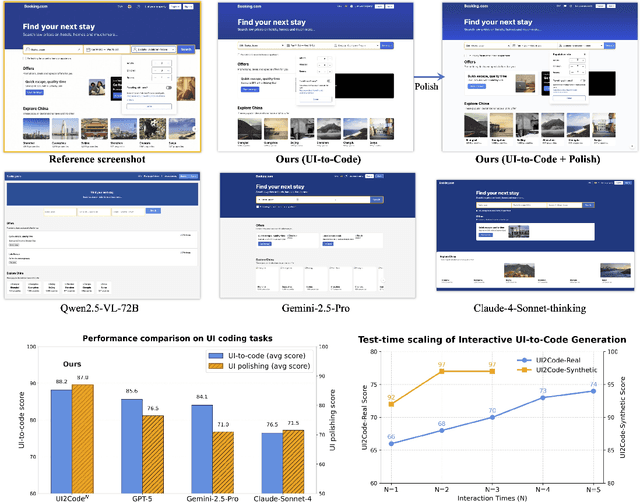
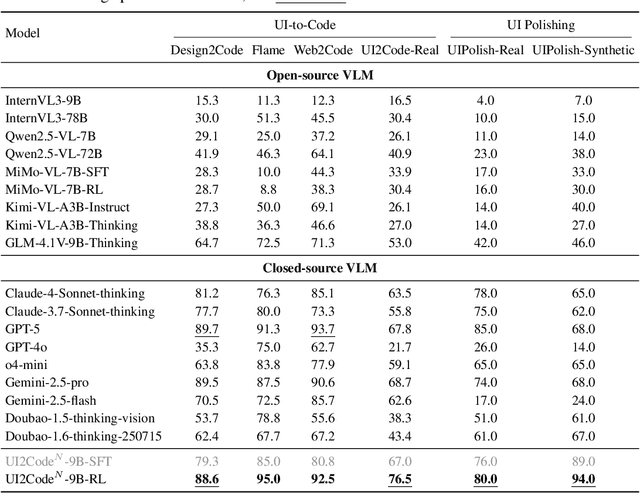
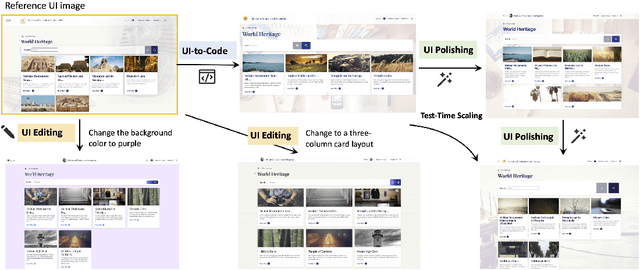

Abstract:User interface (UI) programming is a core yet highly complex part of modern software development. Recent advances in visual language models (VLMs) highlight the potential of automatic UI coding, but current approaches face two key limitations: multimodal coding capabilities remain underdeveloped, and single-turn paradigms make little use of iterative visual feedback. We address these challenges with an interactive UI-to-code paradigm that better reflects real-world workflows and raises the upper bound of achievable performance. Under this paradigm, we present UI2Code$^\text{N}$, a visual language model trained through staged pretraining, fine-tuning, and reinforcement learning to achieve foundational improvements in multimodal coding. The model unifies three key capabilities: UI-to-code generation, UI editing, and UI polishing. We further explore test-time scaling for interactive generation, enabling systematic use of multi-turn feedback. Experiments on UI-to-code and UI polishing benchmarks show that UI2Code$^\text{N}$ establishes a new state of the art among open-source models and achieves performance comparable to leading closed-source models such as Claude-4-Sonnet and GPT-5. Our code and models are available at https://github.com/zai-org/UI2Code_N.
MathSE: Improving Multimodal Mathematical Reasoning via Self-Evolving Iterative Reflection and Reward-Guided Fine-Tuning
Nov 10, 2025Abstract:Multimodal large language models (MLLMs) have demonstrated remarkable capabilities in vision-language answering tasks. Despite their strengths, these models often encounter challenges in achieving complex reasoning tasks such as mathematical problem-solving. Previous works have focused on fine-tuning on specialized mathematical datasets. However, these datasets are typically distilled directly from teacher models, which capture only static reasoning patterns and leaving substantial gaps compared to student models. This reliance on fixed teacher-derived datasets not only restricts the model's ability to adapt to novel or more intricate questions that extend beyond the confines of the training data, but also lacks the iterative depth needed for robust generalization. To overcome these limitations, we propose \textbf{\method}, a \textbf{Math}ematical \textbf{S}elf-\textbf{E}volving framework for MLLMs. In contrast to traditional one-shot fine-tuning paradigms, \method iteratively refines the model through cycles of inference, reflection, and reward-based feedback. Specifically, we leverage iterative fine-tuning by incorporating correct reasoning paths derived from previous-stage inference and integrating reflections from a specialized Outcome Reward Model (ORM). To verify the effectiveness of \method, we evaluate it on a suite of challenging benchmarks, demonstrating significant performance gains over backbone models. Notably, our experimental results on MathVL-test surpass the leading open-source multimodal mathematical reasoning model QVQ. Our code and models are available at \texttt{https://zheny2751\allowbreak-dotcom.github.io/\allowbreak MathSE.github.io/}.
WebVIA: A Web-based Vision-Language Agentic Framework for Interactive and Verifiable UI-to-Code Generation
Nov 09, 2025Abstract:User interface (UI) development requires translating design mockups into functional code, a process that remains repetitive and labor-intensive. While recent Vision-Language Models (VLMs) automate UI-to-Code generation, they generate only static HTML/CSS/JavaScript layouts lacking interactivity. To address this, we propose WebVIA, the first agentic framework for interactive UI-to-Code generation and validation. The framework comprises three components: 1) an exploration agent to capture multi-state UI screenshots; 2) a UI2Code model that generates executable interactive code; 3) a validation module that verifies the interactivity. Experiments demonstrate that WebVIA-Agent achieves more stable and accurate UI exploration than general-purpose agents (e.g., Gemini-2.5-Pro). In addition, our fine-tuned WebVIA-UI2Code models exhibit substantial improvements in generating executable and interactive HTML/CSS/JavaScript code, outperforming their base counterparts across both interactive and static UI2Code benchmarks. Our code and models are available at \href{https://zheny2751-dotcom.github.io/webvia.github.io/}{\texttt{https://webvia.github.io}}.
Data-Efficient RLVR via Off-Policy Influence Guidance
Oct 30, 2025Abstract:Data selection is a critical aspect of Reinforcement Learning with Verifiable Rewards (RLVR) for enhancing the reasoning capabilities of large language models (LLMs). Current data selection methods are largely heuristic-based, lacking theoretical guarantees and generalizability. This work proposes a theoretically-grounded approach using influence functions to estimate the contribution of each data point to the learning objective. To overcome the prohibitive computational cost of policy rollouts required for online influence estimation, we introduce an off-policy influence estimation method that efficiently approximates data influence using pre-collected offline trajectories. Furthermore, to manage the high-dimensional gradients of LLMs, we employ sparse random projection to reduce dimensionality and improve storage and computation efficiency. Leveraging these techniques, we develop \textbf{C}urriculum \textbf{R}L with \textbf{O}ff-\textbf{P}olicy \text{I}nfluence guidance (\textbf{CROPI}), a multi-stage RL framework that iteratively selects the most influential data for the current policy. Experiments on models up to 7B parameters demonstrate that CROPI significantly accelerates training. On a 1.5B model, it achieves a 2.66x step-level acceleration while using only 10\% of the data per stage compared to full-dataset training. Our results highlight the substantial potential of influence-based data selection for efficient RLVR.
Tibetan Language and AI: A Comprehensive Survey of Resources, Methods and Challenges
Oct 22, 2025Abstract:Tibetan, one of the major low-resource languages in Asia, presents unique linguistic and sociocultural characteristics that pose both challenges and opportunities for AI research. Despite increasing interest in developing AI systems for underrepresented languages, Tibetan has received limited attention due to a lack of accessible data resources, standardized benchmarks, and dedicated tools. This paper provides a comprehensive survey of the current state of Tibetan AI in the AI domain, covering textual and speech data resources, NLP tasks, machine translation, speech recognition, and recent developments in LLMs. We systematically categorize existing datasets and tools, evaluate methods used across different tasks, and compare performance where possible. We also identify persistent bottlenecks such as data sparsity, orthographic variation, and the lack of unified evaluation metrics. Additionally, we discuss the potential of cross-lingual transfer, multi-modal learning, and community-driven resource creation. This survey aims to serve as a foundational reference for future work on Tibetan AI research and encourages collaborative efforts to build an inclusive and sustainable AI ecosystem for low-resource languages.
Pure-Pass: Fine-Grained, Adaptive Masking for Dynamic Token-Mixing Routing in Lightweight Image Super-Resolution
Oct 02, 2025Abstract:Image Super-Resolution (SR) aims to reconstruct high-resolution images from low-resolution counterparts, but the computational complexity of deep learning-based methods often hinders practical deployment. CAMixer is the pioneering work to integrate the advantages of existing lightweight SR methods and proposes a content-aware mixer to route token mixers of varied complexities according to the difficulty of content recovery. However, several limitations remain, such as poor adaptability, coarse-grained masking and spatial inflexibility, among others. We propose Pure-Pass (PP), a pixel-level masking mechanism that identifies pure pixels and exempts them from expensive computations. PP utilizes fixed color center points to classify pixels into distinct categories, enabling fine-grained, spatially flexible masking while maintaining adaptive flexibility. Integrated into the state-of-the-art ATD-light model, PP-ATD-light achieves superior SR performance with minimal overhead, outperforming CAMixer-ATD-light in reconstruction quality and parameter efficiency when saving a similar amount of computation.
TDRM: Smooth Reward Models with Temporal Difference for LLM RL and Inference
Sep 18, 2025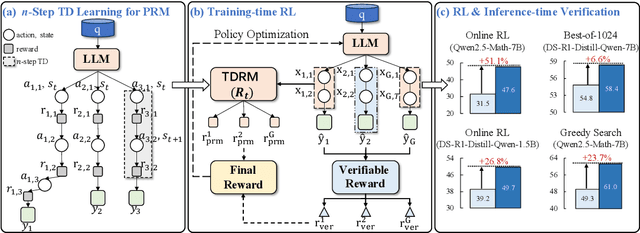

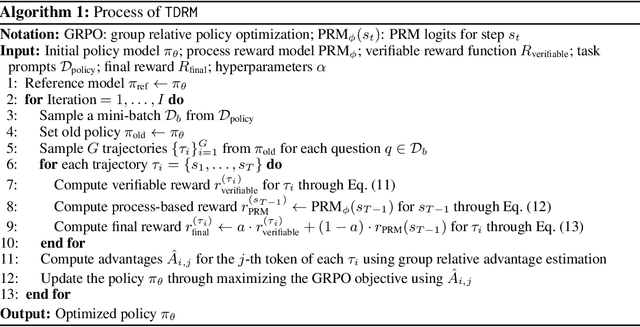

Abstract:Reward models are central to both reinforcement learning (RL) with language models and inference-time verification. However, existing reward models often lack temporal consistency, leading to ineffective policy updates and unstable RL training. We introduce TDRM, a method for learning smoother and more reliable reward models by minimizing temporal differences during training. This temporal-difference (TD) regularization produces smooth rewards and improves alignment with long-term objectives. Incorporating TDRM into the actor-critic style online RL loop yields consistent empirical gains. It is worth noting that TDRM is a supplement to verifiable reward methods, and both can be used in series. Experiments show that TD-trained process reward models (PRMs) improve performance across Best-of-N (up to 6.6%) and tree-search (up to 23.7%) settings. When combined with Reinforcement Learning with Verifiable Rewards (RLVR), TD-trained PRMs lead to more data-efficient RL -- achieving comparable performance with just 2.5k data to what baseline methods require 50.1k data to attain -- and yield higher-quality language model policies on 8 model variants (5 series), e.g., Qwen2.5-(0.5B, 1,5B), GLM4-9B-0414, GLM-Z1-9B-0414, Qwen2.5-Math-(1.5B, 7B), and DeepSeek-R1-Distill-Qwen-(1.5B, 7B). We release all code at https://github.com/THUDM/TDRM.
ReST-RL: Achieving Accurate Code Reasoning of LLMs with Optimized Self-Training and Decoding
Aug 27, 2025Abstract:With respect to improving the reasoning accuracy of LLMs, the representative reinforcement learning (RL) method GRPO faces failure due to insignificant reward variance, while verification methods based on process reward models (PRMs) suffer from difficulties with training data acquisition and verification effectiveness. To tackle these problems, this paper introduces ReST-RL, a unified LLM RL paradigm that significantly improves LLM's code reasoning ability by combining an improved GRPO algorithm with a meticulously designed test time decoding method assisted by a value model (VM). As the first stage of policy reinforcement, ReST-GRPO adopts an optimized ReST algorithm to filter and assemble high-value training data, increasing the reward variance of GRPO sampling, thus improving the effectiveness and efficiency of training. After the basic reasoning ability of LLM policy has been improved, we further propose a test time decoding optimization method called VM-MCTS. Through Monte-Carlo Tree Search (MCTS), we collect accurate value targets with no annotation required, on which VM training is based. When decoding, the VM is deployed by an adapted MCTS algorithm to provide precise process signals as well as verification scores, assisting the LLM policy to achieve high reasoning accuracy. We validate the effectiveness of the proposed RL paradigm through extensive experiments on coding problems. Upon comparison, our approach significantly outperforms other reinforcement training baselines (e.g., naive GRPO and ReST-DPO), as well as decoding and verification baselines (e.g., PRM-BoN and ORM-MCTS) on well-known coding benchmarks of various levels (e.g., APPS, BigCodeBench, and HumanEval), indicating its power to strengthen the reasoning ability of LLM policies. Codes for our project can be found at https://github.com/THUDM/ReST-RL.
ObjFiller-3D: Consistent Multi-view 3D Inpainting via Video Diffusion Models
Aug 25, 2025Abstract:3D inpainting often relies on multi-view 2D image inpainting, where the inherent inconsistencies across different inpainted views can result in blurred textures, spatial discontinuities, and distracting visual artifacts. These inconsistencies pose significant challenges when striving for accurate and realistic 3D object completion, particularly in applications that demand high fidelity and structural coherence. To overcome these limitations, we propose ObjFiller-3D, a novel method designed for the completion and editing of high-quality and consistent 3D objects. Instead of employing a conventional 2D image inpainting model, our approach leverages a curated selection of state-of-the-art video editing model to fill in the masked regions of 3D objects. We analyze the representation gap between 3D and videos, and propose an adaptation of a video inpainting model for 3D scene inpainting. In addition, we introduce a reference-based 3D inpainting method to further enhance the quality of reconstruction. Experiments across diverse datasets show that compared to previous methods, ObjFiller-3D produces more faithful and fine-grained reconstructions (PSNR of 26.6 vs. NeRFiller (15.9) and LPIPS of 0.19 vs. Instant3dit (0.25)). Moreover, it demonstrates strong potential for practical deployment in real-world 3D editing applications. Project page: https://objfiller3d.github.io/ Code: https://github.com/objfiller3d/ObjFiller-3D .
 Add to Chrome
Add to Chrome Add to Firefox
Add to Firefox Add to Edge
Add to Edge